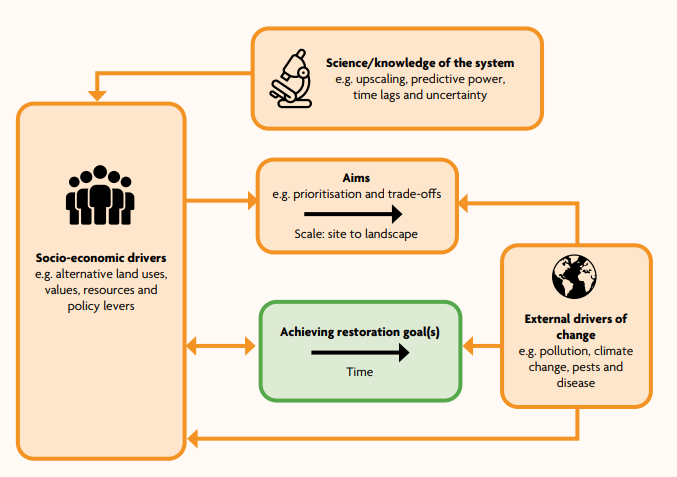environmental SCIENTIST | Ecosystem restoration: Securing biodiversity, complexity and resilience | September 2022
Kirsty Park, Ben McCarthy and Jim Harris examine the drivers and challenges of setting and achieving ecosystem restoration goals.
At first people refuse to believe that a strange new thing can be done. Then they begin to hope it can be done. They see it can be done. Then it is done and all the world wonders why it was not done centuries ago.1
While the need and urgency for ecosystem restoration is widely recognised – as reflected in the current United Nations Environment Programme’s Decade of Restoration2 – how to translate such a laudable ambition into tangible biological outcomes is problematic while fundamental challenges of what restoration means in practice and how to achieve it remain. For example, what interventions will be appropriate to meet the challenges of locked-in environmental change and how can these be translated into tangible actions at a sufficient scale? What are the key issues that remain to be resolved in order to achieve ecological restoration and what are appropriate targets that are fit for the future and work with the current knowledge gaps and inevitable land use choices that society faces (see Figure 1)?
Figure 1. Conceptual figure illustrating the key drivers influencing the success or otherwise of restoration goals.
Framing our restoration ambitions
Although the aim of restoration sounds like it should be obvious – to bring back or re-establish something of the past – there is increasing scrutiny on whether returning land to some previous habitat type with its suite of characteristic species is always appropriate.3 Even where this is practically viable, there is little evidence to suggest that such habitats and ecosystems will necessarily be resilient to the future pressures and drivers of environmental change.
This becomes increasingly pertinent as attention shifts to the societal benefits of restored ecosystems and the services they deliver, such as reduced flood risk from restored flood plain functionality. While such nature-based solutions provide opportunities to meet the interdependent crises of biodiversity loss, ecosystem degradation and climate change, the scale of the necessary response brings into sharp focus the effectiveness of our interventions to go beyond halting the loss of biodiversity into a future focus on the science and practice of ecological restoration.
The Making Space for Nature report rightly called for more nature sites to be ‘more, better, bigger and joined up’ to reverse the decline of UK biodiversity and remains a cornerstone of UK conservation policy and practice.4 This policy approach remains wholly relevant to mitigating and adapting our extant biodiversity to climate change and other environmental pressures. However, as the review panel concludes, the existing network of sites is insufficient to halt the loss of biodiversity and meet current nature targets. What is more, the scale of the twin biodiversity and climate emergencies requires an accelerated adoption of nature-based solutions and at scale, begging the question: how do we best support and facilitate ecosystem recovery and establishment that is fit for the future, meets fundamental societal needs and secures ongoing public support?
The knowledge base for ecosystem restoration
The past 30 years have seen huge advances in the science and practice of restoration ecology. Seminal works by Hobbs and Norton5 and Whisenant6 set the scene for much that was to follow – including recognising the importance of managing abiotic barriers prior to biotic interventions,7 interconnection and feedback loops,8 the role of soil communities in determining re-establishment of plant communities in restoration sites,9 and exciting possibilities for using environmental DNA and soundscapes to assess restoration success.10,11 As early as the 1990s, practitioners were calling for sound scientific grounds upon which to base decisions.12 However, inherent uncertainty remains about how to set ambitious yet achievable goals given that ecosystems are dynamic and success is influenced by broader socio-political policies that can have greater sway on land use and land management decisions, especially at a landscape scale.
The effects of restoration can often take many years to be realised, particularly for habitats with slow development times (e.g. woodland), and there may be delayed responses by species to conservation interventions. Such biological time lags can make it difficult to assess the success or otherwise of restoration and disentangling whether success is yet to be realised or whether action has been insufficient or inappropriate is a major scientific and practical challenge. Further use of milestones, or interim targets linked to specific ecological mechanisms at key points in time, will help policy-makers and land managers assess whether the impact of conservation actions are following the desired trajectory and if the interventions are delivering the required outcomes.13
While there is an increasing number of landscape-scale restoration studies, the majority of these have been carried out at a site level. It is theoretically possible to upscale these interventions but ascertaining the benefits such landscape restoration will deliver with the same degree of confidence as site-level interventions remains problematic. However, the urgency and need for restoration underline the imperative of scaling-up our current restoration activities and so increase the potential benefits for biological diversity and climate change mitigation.
One of the clear challenges of landscape restoration is the competing demands on land use and how best to deploy limited resources to greatest effect. Whatever the goal of the restoration, consideration of trade-offs and unintended consequences is vital if we are to retain public confidence, and it is ultimately for public benefit. Well-publicised examples of ill-considered tree-planting schemes on species-rich grasslands or other open habitats (the antithesis of the ‘right tree, right place’ philosophy) demonstrate the importance of ensuring that interventions to restore healthier, functioning ecosystems are carefully considered and targeted.
External drivers of change
In England, the UK Government’s 25 Year Plan to Improve the Environment14 and new provisions within the Environment Act 2022 such as Local Nature Recovery Strategies may help generate greater clarity on where efforts to restore nature are best placed. The government is also required to report on progress against milestones.
There is a wide range of external drivers that can influence conditions within a restoration area and affect the success of actions taken. These include but are not limited to the extent of historic habitat loss and degradation that will influence both the feasibility of the restoration goal and the remaining species pool within the landscape that can re-colonise restored areas; pollution; effects of invasive species and overexploitation; and increasingly the effects of climate change.15 For smaller sites in particular, species populations will be small, face a suite of genetic consequences and be prone to local extinction.
Socio-economic drivers
A key challenge is how to dedicate larger areas for ecosystem restoration while also maintaining or increasing agricultural productivity to meet demand by a growing human population. Areas dedicated for restoration may reduce the area available for other land uses such as food production and forestry, although there are exceptions to this (e.g. agroecology). Evidence from the marine environment demonstrates that when Marine Protected Areas are appropriately implemented fish populations and other biodiversity more widely increase.16 While a wide range of country-specific policies support restoration activities for the purposes of biodiversity conservation and ecosystem service provision, at the same time many agricultural policies continue to facilitate and reward environmentally damaging actions (e.g. the EU’s Common Agricultural Policy, which supports farmers who cultivate drained peatlands).
In many countries, including the UK, much of the land is privately owned. A key challenge, therefore, can be working with and persuading potentially large numbers of landowners to engage in restoration activities, particularly if resources to facilitate the work are limited or future funding is uncertain. Active restoration work is resource intensive and therefore expensive, so funding is clearly a major challenge and greatly influences the scale and feasibility of restoration actions.
Public perception of landscapes, what is ‘natural’ and the value placed on the land can also challenge the aim of restoration activities at a variety of scales – from heavily overgrazed but much-loved national parks to overzealous mowing of roadside verges for a ‘neater’ aesthetic. This can be a particular issue when more passive forms of restoration are employed, as it may be perceived that areas have simply been abandoned. Such values and attitudes also influence the societal narrative around restoration, which in turn will influence politicians and policy levers.
None of the challenges outlined above are insurmountable, and there are many examples of successful restoration initiatives. However, the gap between what is required to restore functioning ecosystems and what is happening on the ground is immense. Perhaps the biggest challenge of all is the long-term, open-ended nature of restoration: there is no definitive end point. In the face of global changes to our world, we therefore need to find an enduring way to integrate the needs of nature with our needs.
Professor Kirsty Park (University of Stirling) is an applied ecologist interested in the effects of anthropogenic change on biodiversity and developing solutions to mitigate the impacts of humans on wildlife and habitats. She works with a wide range of policy and practitioner organisations, is a Trustee for the Loch Lomond and The Trossachs Countryside Trust, and a member of the Scottish Biodiversity Strategy Programme Advisory Group.
Ben McCarthy is an ecologist working as Head of Nature Conservation & Restoration Ecology at the National Trust. This role involves realising the Trust’s ambition for nature and nature-based climate solutions, contributing towards building the evidence and Trust’s reputation as a leading UK nature conservation organisation.
Professor Jim Harris is a systems ecologist interested in system complexity, function and emergent properties – particularly resilience and how the principles learned from ecology can be applied to the Five Capitals of our socio-ecological system. He principally works in soil microbiology, restoration ecology and ecosystem service research in relation to ecosystem processes.
References
- Hodgson Burnett, F. (1911) The Secret Garden. London: Heinemann.
- United Nations General Assembly (2019) United Nations Decade on Ecosystem Restoration (2021–2030). Resolution A/RES/73/284. Available at: https://digitallibrary.un.org/record/3794317?ln=en (Accessed: 6 August 2022).
- Bullock, J.M., Fuentes-Montemayor, E., McCarthy, B., Park, K., Hails, R.S., Woodcock, B.A., Watts, K., Cornstanje, R. and Harris, J. (2022) Future restoration should enhance ecological complexity and emergent properties at multiple scales. Ecography, 2022 (4). https:// doi.org/10.1111/ecog.05780 (Accessed: 1 August 2022).
- Lawton, J.H., Brotherton, P.N.M., Brown, V.K., Elphick, C., Fitter, A.H., Forshaw, J., Haddow, R.W., Hilborne, S., Leafe, R.N., Mace, G.M., Southgate, M.P., Sutherland, W.J., Tew, T.E., Varley, J. and Wynne, G.R. (2010) Making Space for Nature: A Review of England’s Wildlife Sites and Ecological Network. Technical Report to Defra. https:// www.researchgate.net/publication/268279426_Making_Space_for_ Nature_A_Review_of_England%27s_Wildlife_Sites_and_Ecological_ Network (Accessed: 1 August 2022).
- Hobbs, R.J. and Norton, D.A. (1996) Towards a conceptual framework for restoration ecology. Restoration Ecology, 4 (2), pp. 93–110. https://doi.org/10.1111/j.1526-100X.1996.tb00112.x (Accessed: 1 August 2022).
- Whisenant, S.G. (1999) Repairing Damaged Wildlands: A Process-oriented, Landscape-scale Approach. Cambridge: Cambridge University Press.
- Hobbs, R.J. and Harris, J.A. (2001) Restoration ecology: repairing the Earth’s damaged ecosystems in the new millennium. Restoration Ecology, 9 (2), pp. 239–246. https://doi.org/10.1046/j.1526- 100x.2001.009002239.x (Accessed: 1 August 2022).
- Suding, K.N., Gross, K.L. and Houseman, G.R. (2004) Alternative states and positive feedbacks in restoration ecology. Trends in Ecology & Evolution, 19 (1), 46–53. https://doi.org/10.1016/j.tree.2003.10.005 (Accessed: 6 August 2022).
- Wubs, E.R.J., van der Putten, W.H., Bosch, M. and Bezemer, M. (2016) Soil inoculation steers restoration of terrestrial ecosystems. Nature Plants, 2 (16107). https://www.nature.com/articles/nplants2016107 (Accessed: 1 August 2022).
- Fernandes, K., van der Heyde, M., Bunce, M., Dixon, K., Harris, R.J., Wardell-Johnson, G. and Nevill, P.G. (2018) DNA metabarcoding – a new approach to fauna monitoring in mine site restoration. Restoration Ecology, 26 (6), pp. 1098–1107. https://doi.org/10.1111/ rec.12868 (Accessed: 1 August 2022).
- Borker, A., Buxton, R.T., Jones, I.L., Major, H.L., Williams, J.C., Tershy, B.R. and Croll, D.A. (2019) Do soundscape indices predict landscape scale restoration outcomes? A comparative study of restored seabird island soundscapes. Restoration Ecology, 28 (1), pp. 252–260. https:// doi.org/10.1111/rec.13038 (Accessed: 1 August 2022).
- Clewell, A.F. and Rieger, J.P. (1997) What practitioners need from restoration ecologists. Restoration Ecology, 5 (4), pp. 350–354. https://www.researchgate.net/publication/230011751_What_ Practitioners_Need_from_Restoration_Ecologists (Accessed: 1 August 2022).
- Watts, K., Whytock, R.C., Park, K.J., Fuentes-Montemayor, E., Macgregor, N.A., Duffield, S. and McGowan, P.J.K. (2020) Ecological time-lags and the journey towards conservation success. Nature Ecology & Evolution, 4 (3), pp. 304–311. https://pubmed.ncbi.nlm.nih. gov/31988448 (Accessed: 1 August 2022).
- Department for Environment, Food and Rural Affairs (2018) A Green Future: Our 25 Year Plan to Improve the Environment. https:// assets.publishing.service.gov.uk/government/uploads/system/ uploads/attachment_data/file/693158/25-year-environment-plan. pdf (Accessed: 6 August 2022).
- Harris, J.A., Hobbs, R.J., Aronson, J. and Higgs, E. (2006) Ecological restoration and global climate change. Restoration Ecology, 14 (2), pp. 170–176. https://doi.org/10.1111/j.1526-100X.2006.00136.x (Accessed: 1 August 2022). 16. Davies, B.F.R., Holmes, L., Rees, A., Attrill, M.J., Cartwright, A.Y and Sheehan, E.V. (2021) Ecosystem approach to fisheries management works: how switching from mobile to static fishing gear improves populations of fished and non-fished species inside a marine-protected area. Journal of Applied Ecology, 58 (11), pp. 2463–2478. DOI: 10.1111/1365-2664.13986.
This article featured in the September 2022 edition of the environmental SCIENTIST, Ecosystem restoration: Securing biodiversity, complexity and resilience






